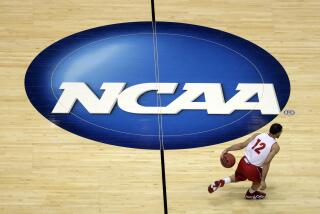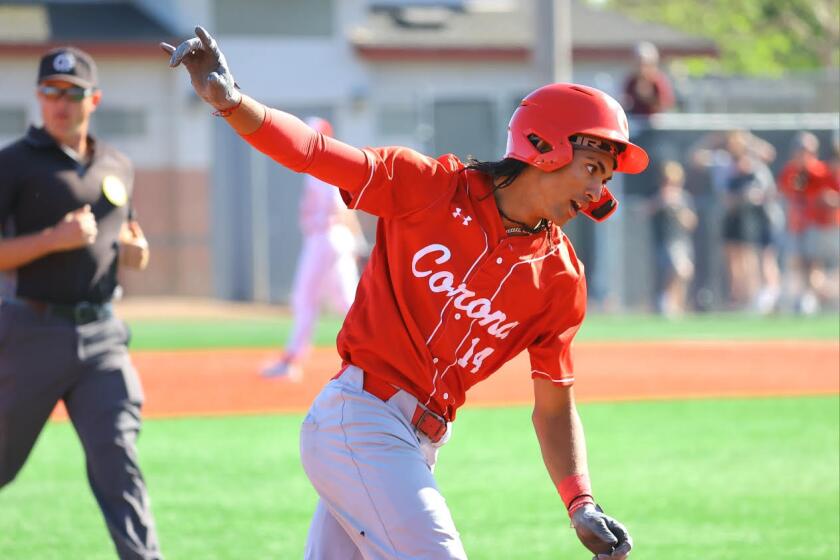A Shock to the NFL System
- Share via
OK, now what?
A landmark court decision issued Thursday may irrevocably affect the way college football is played, coached and recruited.
Or maybe it won’t.
The bottom line on Maurice Clarett vs. the NFL is that college football is still trying to get a line on it.
Clarett was cleared to make himself eligible for April’s NFL draft after his lawyers convinced a federal judge that a league rule barring players from turning professional until they’ve been out of high school for three years violated antitrust laws.
The NFL will appeal the ruling.
Clarett, as a true freshman tailback in 2002, helped lead Ohio State to a national championship. He was suspended his sophomore year for violating NCAA rules.
The fear is that, if Thursday’s decision is upheld on appeal, young players will leave for the NFL en masse, weakening the college game.
“I think it’s an unfortunate ruling, but it’s not a surprising ruling,” Pacific 10 Commissioner Tom Hansen said Thursday. “I think it will cause more impact rather than less. People underestimate the desire of these young people to play for the kind of money available.
“The money just transcends judgment in many cases. Between the players, their families and the ever-present agents and other con artists, there will be a great many people coming out early.”
The American Football Coaches Assn., in a statement, said it was “very disappointed with the ruling handed down by the federal judge in the Maurice Clarett case.”
But are fears founded?
Others argue that, because of the physical and emotional demands, the early leap from college to the NFL is unrealistic for most young players.
Clarett, they say, is an exception because, given his off-the-field problems at Ohio State, fighting the NFL in court was his only option.
“It’s too early to tell what effect this will have on college football if the ruling stands, but I don’t think it will be drastic,” USC Coach Pete Carroll said. “We’ll just have to deal with it and counsel the players.”
Carroll, a former NFL head coach with the New York Jets and New England Patriots before arriving at USC, doesn’t think there will be a mass exodus once the players understand what leaving early for the pros will involve.
“It can be a shock,” Carroll said. “It’s not like being away at college and living in a dorm or frat. Instead, it’s a job and they’re out on their own, living by themselves, and they don’t have built-in friends. It can be a real eye opener.”
Hawaii Coach June Jones, also a former NFL head coach, said that in all his years, he had seen only one freshman or sophomore who was ready to play in the pros: University of Pittsburgh receiver Larry Fitzgerald.
Fitzgerald, like Clarett, was trying gain access to this year’s NFL draft. Fitzgerald, who just finished his sophomore season, was arguing that he fulfilled the NFL eligibility requirement because he spent an extra year at prep school before enrolling in college. After the Clarett decision, the NFL agreed and declared him eligible.
“Fitzgerald, that guy can play,” Jones said. “He looks like an NFL guy right now. But that’s one out of, what, thousands of kids?”
Jones said the NFL wasn’t interested in becoming a child-care center.
“I don’t think the NFL is going to invest a ton of money in some 18-year-old kid with the way the salary cap is,” he said. “They’re up for free agency in four years, so you’ve wasted all that investment.
“In the existing system, I don’t think it will mean much. Because if a kid is not ready to play, they’re not going to give him the bonus money for a first-round pick.
“It would be smart for the players to stay in school, where they can get that money [eventually]. The difference of being a first-round pick and a fifth-round pick is very significant.”
Yet Hansen, the Pac-10 commissioner, worries about the player who thinks he is ready to turn pro.
He says the untold story in college basketball is how many players declare for the NBA draft but never make it.
Hansen, unlike Jones, said NFL general managers will take fliers on prospects if only to protect themselves from their competition.
“Teams are going to face the same thing facing the NBA,” he said. “That is, you’ve got this recognizable, all-world talent, and if you don’t put him on the bench for three or four years until he grows up, someone else will. Can you afford do that?”
Many colleges already have counseling programs for NFL prospects, outlining what a player is risking by leaving early.
Ed Orgeron, USC assistant head coach and recruiting director, says in light of the Clarett ruling, coaches will have to be more diligent.
“We can only do so much,” Orgeron said. “But believe me, with Pete having been in the NFL, they’ll be educated on that subject. Pete’s a pro at that. We should be well equipped to handle this ... if it does affect us.”
For what it’s worth, Orgeron said he had never seen a freshman or sophomore ready to make the NFL jump, and he tutored Cortez Kennedy, Russell Maryland and Warren Sapp while serving as defensive line coach at Miami.
“Most of those Miami guys, they had their best year their junior year or their senior year,” Orgeron said. “You could take an example: Warren Sapp. His sophomore year was OK, his junior year was great. And I think the difference between the junior year and the senior is still a difference.”
Another question for college football is how the Clarett ruling might affect the game’s power structure, should powerhouse schools such as USC start losing star players.
Jones, whose Hawaii team was crushed by USC last season, wouldn’t mind if the college playing field were leveled a bit.
He doesn’t see it happening, though.
“It’s going to be so few people we’re talking about, it’s not going to have an effect,” he said.
The defection of a star player to the NBA can cripple a college basketball program, but Jones says football is better able to absorb losses.
“It’s a little bit different in football because we have 85 scholarships,” Jones said. “One or two guys are not going to matter. You just go get another one.”
*
(BEGIN TEXT OF INFOBOX)
IN THEIR COURT
*--* Others landmark rulings: CURT FLOOD * Jan. 16, 1970: Flood files civil lawsuit challenging baseball’s reserve clause. * Resolution: Flood lost suit in federal court and decision was upheld in U.S. Circuit Court of Appeals in 1971 and U.S. Supreme Court by a 5-3 vote in 1972. ANDY MESSERSMITH AND DAVE McNALLY * 1975 season: Dodger pitcher Messersmith and Expo pitcher McNally test the reserve clause by playing the season without contracts. * Resolution: On Dec. 23, 1975, an arbitrator announced decision in the players’ favor. A federal court upheld Messersmith and McNally free agency. SPENCER HAYWOOD * After a strong sophomore season at University of Detroit, Haywood plays with ABA’s Denver Rockets and later signs with NBA’s Seattle SuperSonics. The NBA files a suit against Haywood and the Sonics because he hadn’t gone through a draft. * Resolution: U.S. Supreme Court ruled in Haywood’s favor. Starting in 1971, underclassmen could enter NBA draft if they could proved “hardship.” HERSCHEL WALKER * Feb. 23, 1983: After his junior season at Georgia, Walker signs with the USFL. The NFL didn’t permit underclassmen to enter draft. * Resolution: In 1990, the NFL amended rule. Players out of high school for three years eligible for the draft. Sources: Los Angeles Times Wire Services, baseballlibrary.com, law.harvard.edu, thisistheusfl.com
*--*
*
QUOTE, UNQUOTE
Reaction to a federal judge’s decision Thursday to overturn the NFL’s eligibility rule for underclassmen, allowing suspended Ohio State tailback Maurice Clarett to enter the 2004 draft:
“I don’t expect our teams as a matter of course to go out and actively entice high school players to try to come into the NFL.”
*
“This ruling is concerning because it could create situations that possibly would limit educational opportunities for young men. College educations are so important for social, intellectual and maturity development as well as the athletic perspective, and this ruling could thwart those opportunities.”
*
“I was in Iraq this summer for eight days with some retired NBA players and the USO and I saw 18-year-olds fighting for our country. I’d love somebody to explain to me how we can send an 18-year-old to war, but we can’t to the NFL.”
*
“I know guys are going to be gunning after him a little more because of all the stuff he has done. Because of the way he’s done all these things, some people here see it as disrespectful. I’m sure guys are going to break his tail, try to break him in.”
LaVar Arrington,
Washington Redskin linebacker who left Penn State after his junior year to enter the NFL draft
*
“It’s tough when you’re 23. It’s tough when you’re 30. If they let this go, then you’re going to have high school seniors thinking about going to the NFL.”
*
“We are disappointed.... It is too early to know how or how soon this will affect college football, but it clearly opens the door to more football student-athletes leaving college early and without degrees.”
*
“I disagree with this ruling. The rationale behind the NFL’s policy is to provide the kids time to mature physically for the impact, violence and speed of the game. The No. 1 priority should be the safety and welfare of the student athletes.”
*
“Does this open the doors for all the freshmen that want to come out and jump straight into the league? The thing about football, you can’t just come out of high school and play with grown men.”
*
“Everybody talks about the success of Kobe and LeBron and Garnett and those guys in the NBA, but for every one of them, there’s probably two guys that didn’t make it, and now what are they doing?”
More to Read
Go beyond the scoreboard
Get the latest on L.A.'s teams in the daily Sports Report newsletter.
You may occasionally receive promotional content from the Los Angeles Times.











